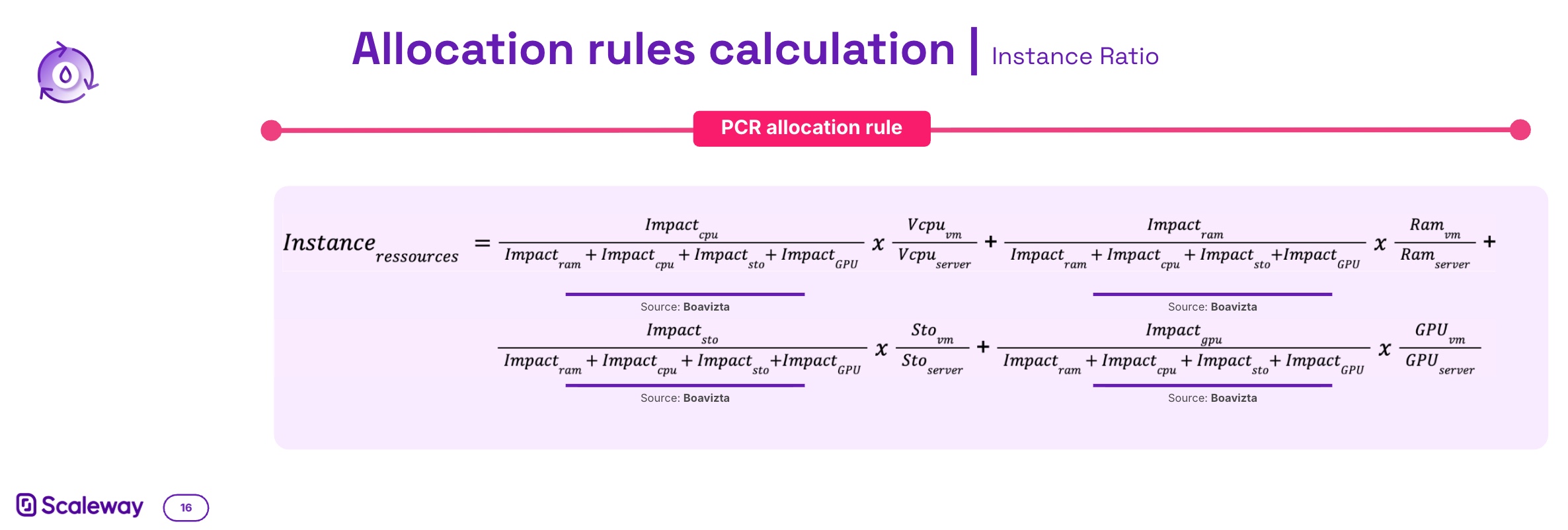Instances footprint calculation
Console overview
Discover how to measure your footprint for Instances on the Scaleway console.
For Virtual Instances, the calculation of the environmental footprint takes into consideration all the elements described on the Environmental Footprint calculation breakdown documentation page.
Calculation aspects
The following elements are considered in the Instance footprint calculation:
- Hypervisor resources - the resources (CPU, GPU, RAM, and disk, for example) used in the physical hypervisor servers that create and run the virtual Instances.
- Instance offer resources - the vCPU, GPU, RAM, and disk resources used when you use an Instance.
The calculation using the elements above can be broken down into:
Manufacturing Impact
- Manufacturing of the underlying physical servers (hypervisors) necessary to run the Instances.
- Distribution of the manufacturing impact according to the resources consumed by the Instance (vCPU, RAM, storage).
Operational Impact
- Energy consumption of the hypervisors during Instance usage.
- Power Usage Effectiveness (PUE) specific to the data center where the Instance is hosted.
- Energy mix of the country that provides the electricity.
Usage Impact
- Resources consumed by the Instance, calculated based on the material specifications of the hypervisors.
Indirect Emissions
- Impact related to cross-functional services necessary to guarantee the operation of the Instance, such as network and shared storage.
Instance consumption ratio
When calculating an Instance's footprint, we consider the resources based on their relative usage on the hypervisor to ensure an accurate distribution of their proportional consumption.
- CPUs - Consider the share of vCPUs reserved compared to the total number of physical cores available.
- GPUs - Consider the share of GPUs reserved compared to the total number of physical cores available.
- RAM - Consider the share of allocated RAM compared to the total RAM of the hypervisor.
- Storage - Consider the use of allocated storage compared to the total capacity of the hypervisor.

The value derived from this calculation will be used in every step of the calculation of the Instance's footprint. The variable is represented as Resources_Used_VM in the image above.
Refer to the table below to understand how the Resources_Used_VM is integrated into the calculation of each aspect of the total footprint calculation.
To obtain an accurate calculation of the Instance's footprint, we multiply the results in each step of the basis calculation, bar the Cross-IT equipment & stock calculations step, by the Resources_Used_VM ratio.
Electricity consumption calculation
The only part of the calculation that will differ from the basis is the Customer Servers section.
To calculate the electrical consumption of Instances, instead of using an exact measure of the power consumption, we use a proxy, e.g. CPU usage. The relationship between CPU usage and the power consumption of the underlying machine is non-linear, and characterised by a consumption profile.
A consumption profile is a formula that takes in a given workload (e.g. % CPU usage), and returns the estimated power consumption of the machine.
We use the consumption profiles defined by Boavizta for the CPUs used on Scaleway Instances.
For the Environmental Footprint Estimation, we base the calculation on a theoretical value of 30% CPU usage. On your monthly report, we use your real CPU consumption to provide you with the most reliable data possible.
Calculation example
In the example below we will calculate the manufacturing impact allocated to an Instance for an 100 hour usage period.
Consider the following characteristics:
| Resource | Instance | Hypervisor |
|---|---|---|
| vCPU | 4 | 16 CPU cores |
| RAM | 8 GB | 64 GB |
| Storage | 50 GB | 1 TB (1000 GB) |
| Lifespan (in years) | 6 years = 52560h | |
| Manufacturing impact | 100 kgCo2e |
The allocation of the hypervisor resources for this particular Instance is calculated in the following manner:
| Resource | Allocation |
|---|---|
| CPU | 4/16 = 0.25 |
| RAM | 8/64 = 0.125 |
| Storage | 50/1000 = 0.05 |
| Total Instance Share | 0.25 + 0.125 + 0.05 = 0.425 |
We multiply the resource allocation by the Instance's lifespan ratio and the hypervisor's manufacturing impact to obtain the manufacturing impact allocated to the Instance:
(100 hours / 52,680 hours) * 100 kgCO2e * 0.425 = 0.080 kgCO2eq